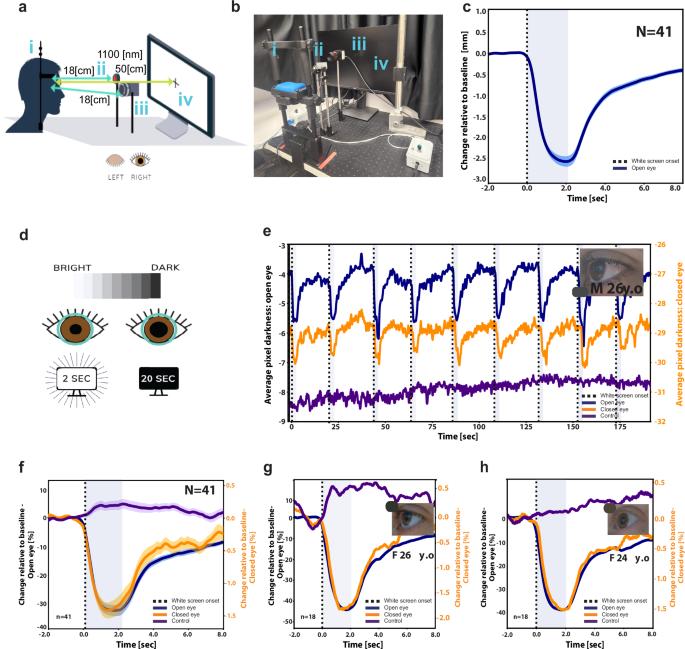Touchless short-wave infrared imaging for dynamic rapid pupillometry and gaze estimation in closed eyes
IF 5.4
Q1 MEDICINE, RESEARCH & EXPERIMENTAL
引用次数: 0
Abstract
Assessments of gaze direction (eye movements), pupil size, and the pupillary light reflex (PLR) are critical for neurological examination and neuroscience research and constitute a powerful tool in diverse clinical settings ranging from critical care through endocrinology and drug addiction to cardiology and psychiatry. However, current bedside pupillometry is typically intermittent, qualitative, manual, and limited to open-eye cases, restricting its use in sleep medicine, anesthesia, and intensive care. We combined short-wave infrared (SWIR, ~0.9-1.7μm) imaging with image processing algorithms to perform rapid (~30 ms) pupillometry and eye tracking behind closed eyelids. Forty-three healthy volunteers participated in two experiments with PLR evoked by visible light stimuli or directing eye movements towards screen targets. Imaging was performed simultaneously on one eye closed, and the other open eye serving as ground truth. Data analysis was performed with a custom approach quantifying changes in brightness around the pupil area or with a deep learning U-NET-based procedure. Here we show that analysis of SWIR imaging data can successfully measure stimulus-evoked PLR in closed-eye conditions, revealing PLR events in single trials and significant PLRs in nearly all individual subjects, as well as estimating gaze direction. The neural net-based analysis could successfully use closed-eye SWIR data to recreate estimates of open-eye images and assess pupil size. Continuous touchless monitoring of rapid dynamics in pupil size and gaze direction through closed eyes paves the way for developing devices with wide-ranging applications, fulfilling long-standing goals in clinical and research fields. Monitoring eye movements and pupil size is important for both clinical assessments and in biomedical research. However, measurements are usually made on open eyes. We developed a method that continuously monitors pupil size when eyes are closed and compared it to results obtained when eyes are open. Our approach is contactless and can measure pupil size and gaze direction for hours. This approach has many potential clinical and research uses. For example, it could be used to monitor the extent of arousal during and following anesthesia, sleep, and in unconscious patients. Ben Barak-Dror et al. present a short-wave infrared imaging method for touchless monitoring of pupillary light reflex (PLR) and gaze direction in closed eyes. Data obtained is comparable to that obtained from open eyes.

用于动态快速瞳孔测量和闭眼注视估计的无触点短波红外成像。
背景:评估凝视方向(眼球运动)、瞳孔大小和瞳孔光反射(PLR)对于神经系统检查和神经科学研究至关重要,是重症监护、内分泌学、药物成瘾、心脏病学和精神病学等各种临床环境中的有力工具。然而,目前的床旁瞳孔测量通常是间歇性的、定性的、手动的,而且仅限于睁眼病例,限制了其在睡眠医学、麻醉和重症监护中的应用:我们将短波红外(SWIR,约 0.9-1.7μm )成像与图像处理算法相结合,在闭眼后进行快速(约 30 毫秒)瞳孔测量和眼球追踪。43 名健康志愿者参加了由可见光刺激或引导眼球运动到屏幕目标所诱发的 PLR 的两项实验。成像同时在一只闭着的眼睛和另一只睁着的眼睛上进行。数据分析采用定制方法量化瞳孔周围的亮度变化,或基于深度学习的 U-NET 程序:结果:我们在此表明,分析 SWIR 成像数据可以成功测量闭眼条件下刺激诱发的 PLR,揭示单次试验中的 PLR 事件和几乎所有受试者的显著 PLR,以及估计注视方向。基于神经网络的分析可以成功地利用闭眼的西南红外数据重现睁眼图像的估计值并评估瞳孔大小:结论:通过闭眼对瞳孔大小和注视方向的快速动态进行连续无接触监测,为开发具有广泛应用的设备铺平了道路,实现了临床和研究领域的长期目标。
本文章由计算机程序翻译,如有差异,请以英文原文为准。
求助全文
约1分钟内获得全文
求助全文

 求助内容:
求助内容: 应助结果提醒方式:
应助结果提醒方式:


